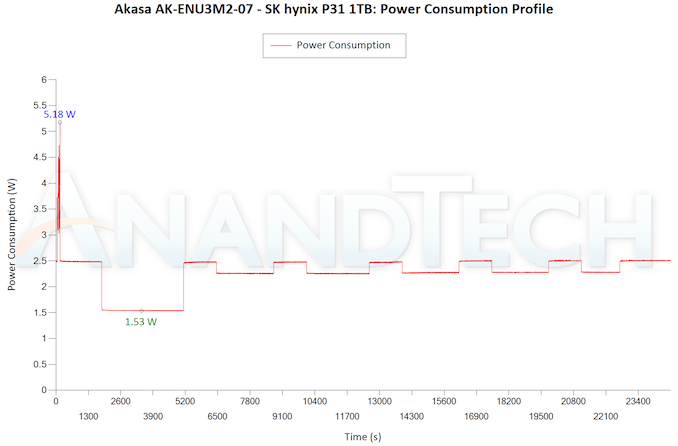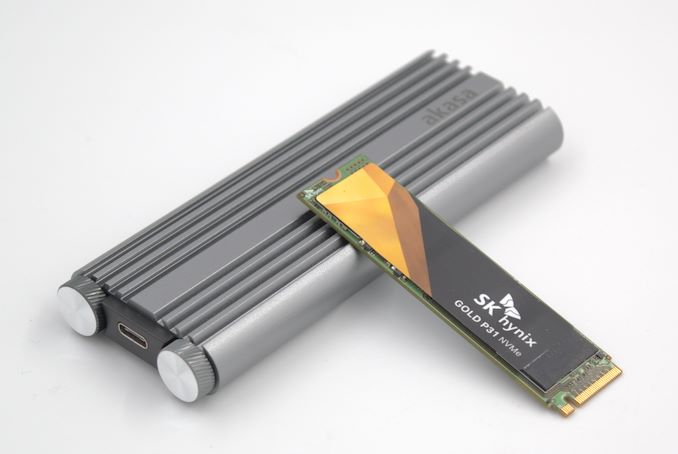Akasa AK-ENU3M2-07 USB 3.2 Gen 2x2 SSD Enclosure Review: 20Gbps with Excellent Thermals
by Ganesh T S on August 1, 2022 8:00 AM ESTMiscellaneous Aspects and Concluding Remarks
The performance of the storage bridges / drives in various real-world access traces as well as synthetic workloads was brought out in the preceding sections. We also looked at the performance consistency for these cases. Power users may also be interested in performance consistency under worst-case conditions, as well as drive power consumption. The latter is also important when used with battery powered devices such as notebooks and smartphones. Pricing is also an important aspect. We analyze each of these in detail below.
Worst-Case Performance Consistency
Flash-based storage devices tend to slow down in unpredictable ways when subject to a large number of small-sized random writes. Many benchmarks use that scheme to pre-condition devices prior to the actual testing in order to get a worst-case representative number. Fortunately, such workloads are uncommon for direct-attached storage devices, where workloads are largely sequential in nature. Use of SLC caching as well as firmware caps to prevent overheating may cause drop in write speeds when a flash-based DAS device is subject to sustained sequential writes. From a storage enclosure perspective, the key aspect to evaluate is the possibility of overheating.
Our Sequential Writes Performance Consistency Test configures the device as a raw physical disk (after deleting configured volumes). A fio workload is set up to write sequential data to the raw drive with a block size of 128K and iodepth of 32 to cover 90% of the drive capacity. The internal temperature is recorded at either end of the workload, while the instantaneous write data rate and cumulative total write data amount are recorded at 1-second intervals.
| Sequential Writes to 90% Capacity - Performance Consistency | |
| TOP: | BOTTOM: |
 |
|
 |
|
The Akasa AK-ENU3M2-07 has the best thermal performance amongst all evaluated solutions, with a 11C delta. There is no thermal throttling in the picture. The weight of the enclosure gives us confidence that it can also handle SSDs that thirst for more power than what the SK hynix Gold P31 consumes.
Power Consumption
Bus-powered devices can configure themselves to operate within the power delivery constraints of the host port. While Thunderbolt ports are guaranteed to supply up to 15W for client devices, USB 2.0 ports are guaranteed to deliver only 4.5W (900mA @ 5V). In this context, it is interesting to have a fine-grained look at the power consumption profile of the various external drives. Using the Plugable USBC-TKEY, the bus power consumption of the enclosures / drives was tracked while processing the CrystalDiskMark workloads (separated by 5s intervals). The graphs below plot the instantaneous bus power consumption against time, while singling out the maximum and minimum power consumption numbers.
| CrystalDiskMark Workloads - Power Consumption | |
| TOP: | BOTTOM: |
 |
|
 |
|
The Akasa AK-ENU3M2-07 and the Yottamaster HC2-C3 seem to suffer from the same firmware issues when it comes to power consumption behavior. Neither enclosure enters a lower power state successfully within the evaluated time interval, and keeps consuming around 2.5W from the port for no reason in our setup. Contrast this with the Silverstone MS12 that enters a 0.5W power consumption state within minutes of starting to idle. From the perspective of power consumption, the AK-ENU3M2-07 can do with some improvements.
One of the idiosyncrasies we encountered with the Akasa unit was that the enclosure was becoming inaccessible after idling for some time. In order to debug this issue, we kept the power recording on for an extended duration after subjecting it to some traffic.
The problem seems to be related to the AK-ENU3M2-07's attempt to enter a low power state - after around 30 minutes of no activity, the power consumption drops from 2.6W down to around 1.1W - but, the device silently drops out (the OS doesn't realize that the device is inaccessible until some traffic is directed to the drive inside). The major issue here is that unless the enclosure is manually disconnected and reconnected, it is not possible for the storage drive to start working again. This is not an acceptable behavior for many use-cases where the SSD is expected to idle for a long duration but be ready when the user sends traffic to it. Strangely, we didn't see the problem with the Yottamaster HC12 which seems to have similar power consumption behavior in the CrystalDiskMark test. We have communicated our findings to Akasa, and hopefully, the issue can be resolved with firmware updates.
Concluding Remarks
Akasa distributes its SSD enclosures in multiple market regions. Unfortunately, they are not directly available in the North American market, with the focus in the US being more on their fanless PC cases. In the UK, the AK-ENU3M2-07 can be purchased for GBP 69, with a shipping option to the US. The best enclosure we have seen in the US market is the Silverstone MS12 (USD 70), but consumers in other regions have an alternative in the form of the Akasa unit.
Akasa's M.2 SSD enclosures lineup is quite comprehensive in terms of addressing various market requirements, and the AK-ENU3M2-07 is a worthy flagship addition. After having evaluated three different ASM2364 enclosures for 20Gbps SSDs, we have come to appreciate the different approaches taken by each vendor. Akasa's build and industrial design for the AK-ENU3M2-07 is subjectively attractive, while the thermal solution is objectively top-notch. If a power-hungry SSD is planned on being used, it gets the vote ahead of the others. The Silverstone MS12 is a more well-rounded solution. The Yottamaster HC2 uses very similar firmware to the Akasa one, but it does not support a tool-free experience. Overall, consumers will find the Akasa AK-ENU3M2-07 to be a solution satisfying most of their M.2 NVMe SSD enclosure requirements, as long as the enclosure is not left idle for too long a period when connected to the host system.












15 Comments
View All Comments
back2future - Tuesday, August 2, 2022 - link
Even Thunderbolt 3 enclosures are on a >~$75, ASM4242 (<=64Gb/s) and JHL8440/JHL8540 for TB4 seems being discussed (, with even TB5 data (80Gb/s) given to public 2021, ~one year ago).Are there (external consumer) Usb 3.2 hubs available?
abufrejoval - Monday, August 8, 2022 - link
My feeling is that in terms of ease of handling NVMe has just been an enormous stepback vs. SATA SSDs.I love how I could just play around with them like in the good old floppy days, put them here, put them there, move them from system to system, have them be a boot drive here, back them up via another one there, join them into a JBOD/RAID0 a little later in life etc. I've always hated storage being tied to a system, something rather unnatural in early computers and something that IMHO Microsoft mostly pushed to fight pirating in pre-permanently-online times.
Tray-less hot-swap drive bay caddies for where the CD/DVD drives used to go in notebooks extended that enormous flexibility there, too. Sometimes I'd even move a complex long-running application setup (e.g. Ansible) to a different system for speed and then pop it back into the low-noise one where it was supposed to run after being all ready.
Far too often the ability to pop out every other drive when installing a newish OS was the only way to preserve a production environment from the newcomer thrashing man-years to bits.
U.2 caddies for M.2 almost deliver similar flexibility again, but come at quite a bit of a premium. But that would only really pay off, if Thunderbolt was universally available on notebooks and NUCs for external attachment.
Because it's not just speed that suffers from USB vs. PCIe, but also compatibility in the form of device naming.
If you move M.2 NVMe drives from an on-board slot or TB to something USB or vice versa, there is a good chance you'll loose the ability to boot the system.
And then there is all sorts of renumbering of partitions, automatic UEFI reconfiguration when disks are inserted temporarily, which have nothing to do with USB vs. NVMe but how ancient DOS (disk operating systems) have a hard time dealing with the dynamics enabled by hardware today.
The Silicon Motion SM2320 in the Data Traveler proves rather well, that near NVMe performance can be put into a size and power envelope that is no longer a compromise between size and performance: it's not quite µ-SDcard in terms of size, but it's a far step from the clunky 1st gen external TB drive enclosures while performance is getting nicely close to native NVMe.
What we lack is a physical form factor to go along with it. Yes, external fully plugable is nice. Until you boot or depend on it and move the hosting notebook around. Then you'd rather not have it sticking out, yet removable.
I never considered PCMCIA as being all too big, but these days SO-DIMM slots are getting killed on Ultrabooks for using much less space. Pretty sure you could fit 8TB of storage and 3 Watts of heat dissipation into that form factor today...
I'm also pretty sure something like the Data Traveller (0.25-1/2TB) could be fit into an Ultrabook compatbile Compact Flash form factor, which Apple would oppose for the obvious reason that their business model highly depends on extorting for non-expandability.
If NVMe performance and multiple terabytes could be fit into a µ-SDcard form factor already, none of the above would have been written. I'm not convinced that combination can be achieved very soon.
So as a consumer, I'd have a simple message to the vendors: please get your act together and offer us the highest level of performance and flexibility at the most reasonable price in a form factor that works across the majority of all personal computing devices!
But those guys just want to make money; more money by eliminating competition and customer choice.
lmcd - Thursday, August 18, 2022 - link
Honestly what are you even talking about? I pull NVMe drives from machines and boot them from USB enclosures with absolutely no issues and vice versa up to a dozen times a day.Your SODIMM comments are completely off base. LPDDR5 notebooks are competing in bandwidth with HEDT 4-channel systems from the simple fact that DIMM pins take space. Laptops with SODIMMs give up a lot for SODIMMs, not just space on the board. A laptop with a high-end LPDDR5 configuration can outcompete most consumer desktops in bandwidth.
I think your form factor comments demo that you're just spitballing. On the one hand, we've only recently got native USB SSD controllers. Those will enable other form factors. The space will ramp up soon enough and in small enough form to fit happily in a USB-C flash drive form factor. For insertion, CF has a PCIe-based version. You could've, you know, looked at the wikipedia page for CF before posting?
FGeorge - Tuesday, November 15, 2022 - link
I have 3 nvme SSDs which I constantly swap in and out of this enclosure, one has Windows 11 to go, the other one has Linux mint, and the third one I have it with Windows 7, for when I feel nostalgic. I boot from all three of them with the same speed as I get from my internal gen 4 4x4 Samsung 980pro. The only difference is when I run CrystalDiskmark, and the transfer speeds show to be slower with the external SSDs, But that doesn't affect my usage, and it really doesn't get much easier than swapping these drives in and out. With a SATA 3 SSD, I had to connect the data, plus the power cable, my computer today doesn't even have a SATA power cable connected from the PSU. So, this comment of yours bashing NVME SSDs over SATA SSDs doesn't make much sense.CalliopeAdrianna - Sunday, August 21, 2022 - link
hallo